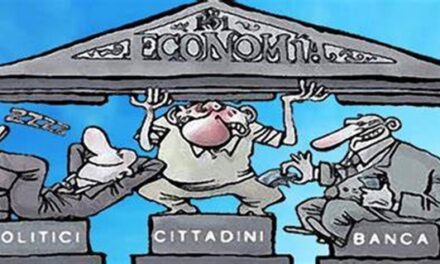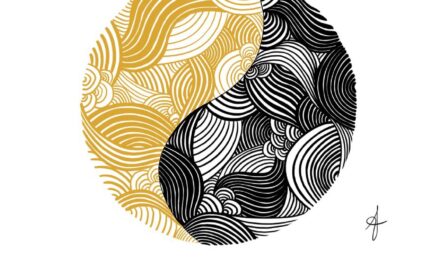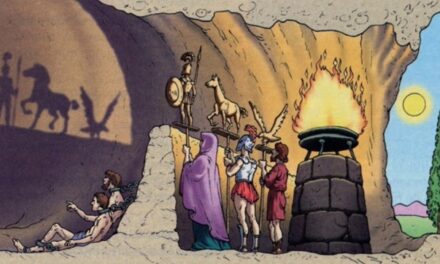Many schools of esoteric and initiatory thought, both in the East and in the West, tend to support the existence of a Unique Primordial Tradition and a hypothetical transcendent unity of religions. However, the Mystery Tradition of the Eleusinian Mother has always strongly opposed such a vision. And in this article, we will explain why.
Moreno Neri, in his excellent and well-thought-out preface to the recent re-edition of Arturo Reghini’s essay “On Western Tradition, writes:
“The branch of the Western Tradition, which is a single aspect of the unique and universal Tradition, has not lost its effectiveness and is still certainly the most compliant with the spiritual constitution and the closest to the fate and duty of an Italian and to his spiritual psychophysical structure. Before arriving at what René Guénon called Primordial Tradition, Frithjof Schuon’s Transcendent Unity, Raphael’s The only Universal Tradition, it would be necessary to follow one’s own tradition, the one most suited to one’s nature, training and historical-cultural roots”.
An impeccable analysis from both a Lamystic and a Pythagorean point of view, and which can certainly be accepted or shared from an Eleusinian point of view except on two particular “nodes”: the question of the alleged uniqueness of the Tradition and of an alleged “Transcendent Unity” of all religions. With regard to these “nodes”, the Eleusinian point of view is rather sharp and clear: we believe that the theories of Guénon, Schuon and Raphael mentioned by Moreno Neri reflect that fallacious cultural orientation which, in the wake of the syncretistic tendencies of late antiquity and the rediscovery late-Medieval and Renaissance of the Hermetic Tradition (which never had anything to do with either Eleusinity or the Mystery Tradition in general), is linked to that deleterious relativistic attitude, unfortunately adopted also by various initiatory orders and also by Freemasonry, which historically resulted in the delirious idea of a presumed “transcendent unity of all religions” in the sign of an equally presumed “Single Primordial Tradition” also contemplated by the Pythagoreans, in particular by late Pythagoreanism. An idea, the latter, that the Eleusinians have always abhorred and strongly refuted. And I will try to explain why.
According to the Eleusinian Mystery Tradition, it is not at all true that all the religions that have formed and/or differentiated over time would indistinctly come from the “primordial religion” enunciated by the Pythagorean-Platonic vision, as adaptations of the Palaios Logos in the form of a Hieros Logos specific to each individual spiritual form. After all, it would be an aberration to think so, since, if we correctly identify in the most authentic Primordial Tradition that original Titanic religion which arose and established itself in that Golden Age in which the Titan Gods still reigned with justice over this world, with the first traumatic breaking of the golden chain of Tradition occurred with the Titanomachy and with the victory of the Olympic Gods, the vast majority of religions that arose and developed and followed one another in the various civilizations, did so under the aegis of the latter, and certainly not under that of the defeated Titan Gods. They have therefore clearly distanced themselves from the Palaios Logos and from the Primordial Tradition, adapting themselves to doctrinal compromises and to pollutions that have allowed, yes, the respective priestly castes to survive and to exercise their own control over the masses of the faithful, but they have thus inexorably and inextricably linked to the catabasic pathway. Such religions have therefore given to their own followers only the illusion of possession of the Sophia Aionia, of the Sapientia Aeterna, while in reality they are clearly distanced from it. If in such religions or doctrines some legacy of the Palaios Logos, of the Titanic Primordial Tradition, can be partially discernible, it represents only a pale and weak shadow.
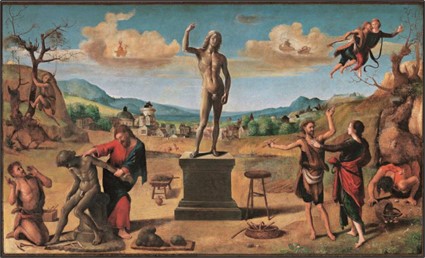
Piero di Cosimo: Prometeus Mith, 1515 (München, Altepinacothek)
The most authentic Primordial Tradition, the one linked to the ancient Titanic cult, managed to survive and perpetuate itself certainly not thanks to the many religions that arose and developed after it, but in spite of them. Indeed, in the history of the last millennia, it has always been the object of systematic persecutions by them and their priestly castes, since nothing can frighten the new usurping Gods and the priestly castes of the religions subservient to them more than an awareness, on the part of humanity, of its true titanic nature and its potential, of a reunification of humanity with its true Primordial Tradition.
If we agree with Gemisto Plethon and with the Pythagoreans on the real existence of an uninterrupted golden chain of the transmission of Tradition (chain of which, as Eleusinians, we have been and continue to be the main actors), we identify with it, yes, the transmission of a Primordial Tradition, but certainly not the same Sophia Aionia, the same Sapientia Aeterna enunciated by the Byzantine Philosopher-Initiate and before him by the whole line of Pythagorean-Platonic continuity.
According to the Eleusinian Mystery Tradition, it is not at all true that all the religions that have formed and/or differentiated over time would indistinctly come from the “primordial religion” enunciated by the Pythagorean-Platonic vision, as adaptations of the Palaios Logos in the form of a Hieros Logos specific to each individual spiritual form.
Even if the true forced Christianization of Imperial Roman society reached its peak under the reign of Theodosius, finding full juridical “legitimation” with the notorious and criminal Edict of Thessalonica, this dramatic katabasic and obscurantist involution of European civilization had decidedly deeper roots. If Constantine and his successors had metaphorically opened the door of the monster’s cage and Theodosius had decisively flung it open, allowing it to come out and unleash its dogmatic and persecutory fury (thus accomplishing what Fabio Calabrese has rightly defined as the most infamous of History[1]),
This monster had already been lurking in the folds of history for some time. I am referring to a tentacled and creeping monster with many names and many faces, emblem of every counter-initiatory principle, which ever since the defeat of the ancient Titan Gods by the usurping Olympian Gods, has punctually reared its head with its own emissaries of turn (Zeus, Dionysus, Amenophis IV, better known as Akhenaten, Moses, Jesus Christ, up to the prophet of Islam Muhammad), working incessantly in the direction of a submission of humanity and a darkening of consciences, with a an objective not only aimed at mere domination or political power, but also and above all at wanting to prevent humanity from regaining possession of that fire once returned to it by Prometheus, from eating the forbidden fruit of the Tree of Knowledge, thus gaining full self-awareness and of that titanic part which is naturally inherent in every man and every woman and which is just waiting to be awakened.
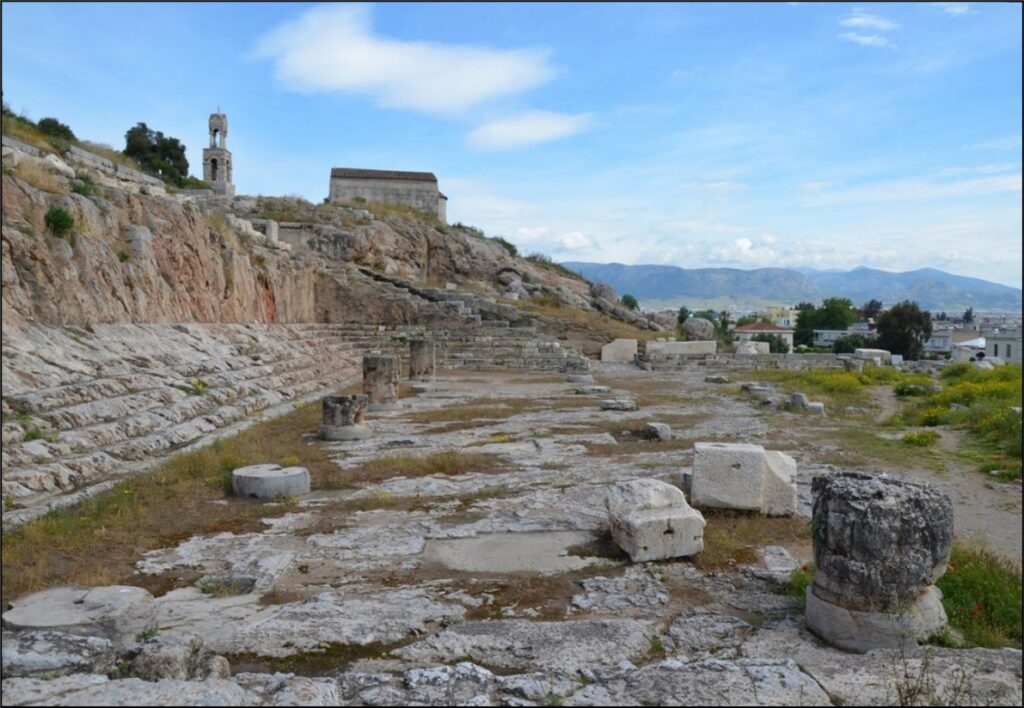
Eleusis: the relics of Telestèrion
As noted by L.M.A. Viola in various of his works and, in particular, in his introductory essay to the Treatise on the Laws of Gemisto Pletone, according to the Pythagorean-Platonic vision, humanity would have known at its dawn an “Integral Divine Truth”, in a paradigmatic time in which the the Eternal Logos would have revealed itself entirely in the Palaios Logos, in the “Original Immanent Divine Word”, constituting the perfection of a “primordial religion”, by virtue of the possession of the Sophia Aionia, of the Sapientia Aeterna. And so far there may be a certain agreement with the Eleusinian vision. But, according to the Pythagorean-Platonic vision, all the religions that were formed and/or differentiated over time would indiscriminately derive from this “primordial religion”, as adaptations of the Palaios Logos in the form of a Hieros Logos specific to each single spiritual form.
And a single golden chain of “Divine Wise-ones” (in the context of which Pythagoras would have played a fundamental role) would have allowed the transmission, in an uninterrupted way, of the “original Divine Wisdom” in the multiple differentiated expressions that it has assumed in the various nations and among different people.
According to this vision, paraphrasing some concepts expressed by Plato in the Politician, humanity would proceed according to a katabasic envelope[2], established by “God”, the same “God” who would have created the world and men, so the light of the “Divine Truth”, and the tradition in the religious institutions of the various civilizations would gradually become obscured, up to its complete concealment in the external life of men. And, in this inexorable katabasic context, the fullness of the light of the “Divine Wisdom” of the origins would be cyclically re-enacted, for ever more limited periods and spaces and involving ever smaller sections of men and civil and religious institutions[3].
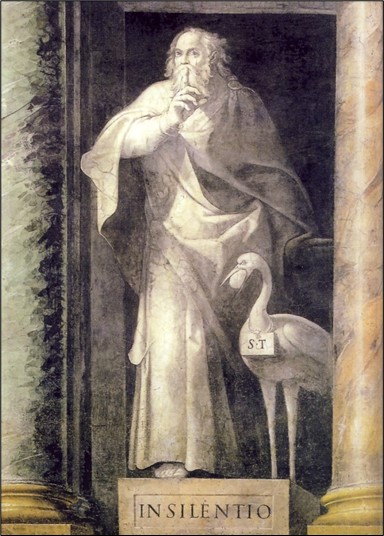
Paris Nogari: Allegory of Silence, fresco from 1582 (Vatican, Sala degli Svizzeri). The work recalls the danger of the word and the risk of committing sins. The stork with the egg in its mouth next to the man reinforces the concept. Having to carry the precious load (the shell contains a secret), he cannot issue verses on pain of destruction of the same.
Due to this presumed katabasic envelop, traditional civilizations would have known – again according to this distorted interpretation – different phases of decadence and relative crises, due to which progressive degradations of their state of original perfection would have been produced, and this same katabasis would have so that humanity progressively distanced itself from its “Divine State” to leave room for the emergence of its “Titanic” element (sigh!), which would be superimposed on an “ancient nature” and a “primordial order”.
It is absolutely necessary here to clarify, because we are faced with a vision that is not only initially wrong, but also and above all profoundly distorted of reality and the state of affairs. A “vision” that I do not hesitate to define as counter-initiatory and markedly Olympian, if not even Dionysian, which overturns for its own use and consumption a whole series of initiatory concepts and truths typical of Eleusinity and the most authentic Western Tradition.
As I pointed out in the fourth part of the first volume of my essay From Eleusis to Florence: the Transmission of a Secret Knowledge, until the Titans reigned over this world humanity lived in the fullest and most complete harmony and symbiosis with its creators. Only following the religious upheaval that originates from the Titanomachy and the victory of the new usurping Olympic Gods did the deleterious and nefarious concept of hybris originated. And this is because, from that moment on, any attempt, both by the defeated Titans to redeem and liberate humanity, both by the latter to raise one own’s head, to open one own’s eyes and to rekindle the torch of Knowledge, was inevitably seen by the new rulers as an intolerable act of arrogance and pride, an “impious” act and therefore to be severely punished
We Eleusinians have always categorically and forcefully rejected the principle of a presumed transcendent unity of religions, as well as the aberrant idea that there could be an “absolute esotericism” deriving from a presumed all-encompassing and unitary “Single Primordial Tradition”, both in the forms and ways in which it was first proclaimed and celebrated by the ancient Pythagorean Tradition and by many personalities of Humanism and the Renaissance afterwards, and in the way it was theorized at the beginning of the 20th century by René Guénon in his doctrine of Unity Metaphysics of Eternal Wisdom. And even less as it was more recently outlined by Frithjof Schuon in his essay Transcendent Unity of All Religions.
For us Eleusinians there is therefore a Primordial and original Tradition, but we do recognize and identify it exclusively with the pre-Olympic, and therefore pre-Hellenic, Titanic religion. That great common religion which, before the religious and cultural overthrow wrought with the Titanomachy and with the consequent establishment of the social system of patriarchy and the cult of new usurping Gods, was practiced and transmitted by all the peoples of the Blue West, therefore by all the European, Mediterranean and near-Eastern populations, from the misty lands of Scotland to North Africa, from the Iberian Peninsula to the Caucasus mountain ranges, from Egypt to the Danube valley, from Crete to Anatolia. That same religion transmitted to humanity in a golden age by the Titan creator Gods, by those Titan Gods of the lineage of Iapetus who created man in their own image and likeness and raised him to his feet, in full dignity, placing their same weapons and their own instruments of power and infusing them, as a true indelible mark, with their own vital and spiritual essence. Therefore, not only the gift of life and immortality of the soul, but also Knowledge and reason, the ability to learn and to distinguish good from evil, truth from falsehood. The ability to learn and follow that single commandment that the Great Father Uranus left to the mortal children of the lineage of
Iapetus: “It is proper for fish, for wild beasts and for flying birds to devour each other. But to you I give Justice, the Truth with a wide pupil”[4].
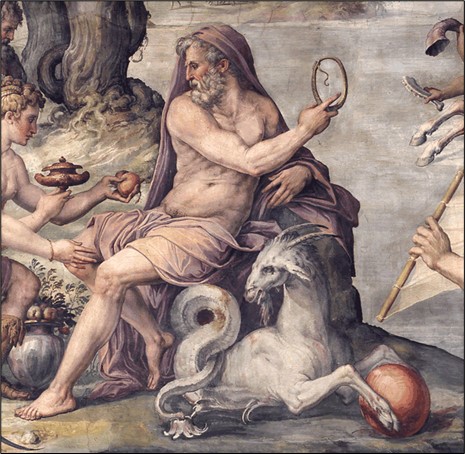
Giorgio Vasari: detail of the fresco “The First Fruits of the Earth Offered to Saturn”, 1557 (Florence, Palazzo Vecchio, Sala degli Elementi)
Whether we like it or not, despite millennia of counter-initiatory conditioning and uninterrupted domination of the new usurper Gods, which over the centuries have gradually manifested themselves in various forms and expressions, sowing false doctrines and generating new false “prophets”(and, with them, new religions founded on dogma and submission, obscurantism and oppression), that spark, that titanic divine essence present in every man, has never been extinguished, and has represented for humanity, even in the darkest stages of its history, the only hope of redemption and liberation. That same titanic divine essence which, paradoxically (but certainly not by chance) is identified by the counter-initiatory traditions and by the Hellenic religion (irreparably contaminated by the Olympian-Dionysian pollution) as an “absolute evil”, if not even as something of “bestial” and “brutal” that would distract men from an alleged “divine state”.
For us Eleusinians there is therefore a Primordial and original Tradition, but we do recognize and identify it exclusively with the pre-Olympic, and therefore pre-Hellenic, Titanic religion.
According to the Eleusinian Mystery Tradition, humanity was in fact created by Atlas, Menoetius, Prometheus and Epimetheus, the four sons of the Titan God Iapetus. And this Tradition teaches us that Atlas gave Knowledge and Life to man, Menoetius the Strenght, both internal and external, Prometheus the male seed and Epimetheus the female.
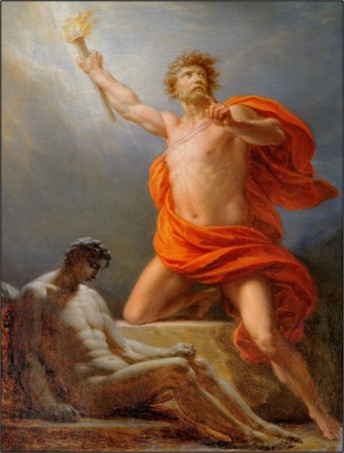
Friedrich Heinrich Füger: Prometheus gives fire to mankind, 1817 (Kessel, Neue Galerie)
The four Titans then, jointly, gave humanity the “Night”, a term that expresses a concept superior to that of “soul” that we commonly understand, the very concept of the Divine Titanic Essence, a perennial and immortal quid, as without the axis of time, which, through and thanks to the work of these four Titans, still dwells today in every man son of the Iapetus Lineage. That same divine essence that still today frightens the defenders of counter-initiatory traditions, so much so that they associate it with something “bestial” and “misleading”, while in reality it represents the exact opposite.
[1] Fabio Calabrese: How the Ancient World Became Christian. Articolo on www.ereticamente.net.
[2] The term Catabasis, associated with the concepts of descent and involution, derives from the ancient Greek term κατάβασις (“descent”), formed by κατα- (“down”) and βαίνω (“to go”), and therefore literally means “to go down”. In ancient Greek literature it mainly indicated the descent into Hades of a living person, a topical motif recurring in many texts. In fact, we find the first literary example of Catabasi in the XIth book of the Odyssey, even if in fact Ulysses does not enter the realm of the dead, stopping on the threshold. On the other hand, the descents into the Underworld of Orpheus, in search of his wife Eurydice, and that of Heracles, in the context of his last effort, have remained famous. The motif was then taken up by the great Initiate Publius Virgil Marone who, in the VIth book of the Aeneid, makes Aeneas enter Hades alive, where he meets Dido, and in the Elysian Fields, where the hero meets his father Anchises, the which shows him his future descendants, from Romulus to Augustus. But the Catabasis is undoubtedly the most well-known one performed by Dante Alighieri in his Comedy: a journey into the afterlife that the poet-Initiate completes accompanied by Virgil.
[3] Ibidem.
[4] Nicola Bizzi: From Eleusis to Florence: the transmission of a secret knowledge. Aurora Boreale Editions, Florence 2017.


